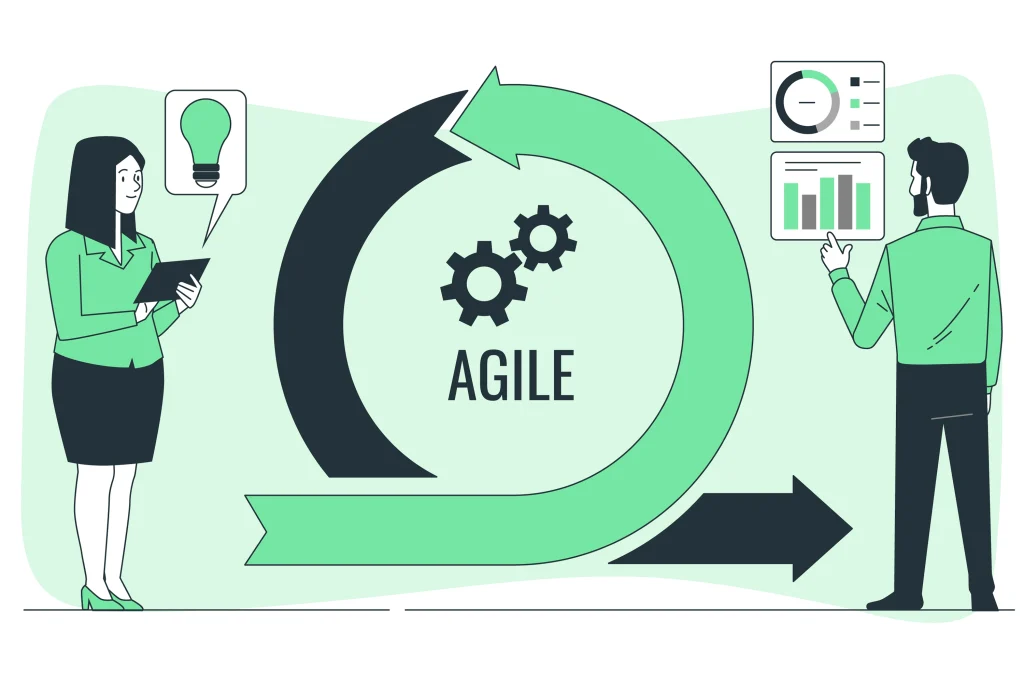
- May 9, 2025
- admin
- 0
When I first stepped into the world of software development, I was overwhelmed by the number of project management methodologies available—Waterfall, Scrum, Kanban, Lean, Spiral, and more. But there was one that stood out from the rest: Agile Development Methodology. The more I worked on projects, the more I realized why Agile had become the gold standard in tech and beyond.
If you’re curious about what makes Agile so effective, you’re in the right place. In this post, I’ll walk you through the top benefits of Agile Development Methodology, backed by real-life examples, and explain why it’s become a cornerstone for high-performing development teams in 2025.
What is Agile Development?
Before diving into the benefits, let’s start with a quick refresher.
Agile Development Methodology is an iterative and incremental approach to software development. Instead of delivering a finished product after months of work, Agile breaks down the process into smaller units called sprints, usually lasting 1 to 4 weeks. Teams deliver a functional piece of software at the end of each sprint and gather feedback to refine future iterations.
The Agile Manifesto emphasizes:
- Individuals and interactions over processes and tools
- Working software over comprehensive documentation
- Customer collaboration over contract negotiation
- Responding to change over following a plan
Now, let’s look at the real-world benefits this approach offers.
Contact our career specialists
1. Faster Time to Market
One of the most noticeable benefits of Agile development is how fast we can deliver usable software. Instead of waiting for months (as in the Waterfall model), Agile enables frequent delivery of working software.
Real-Life Example:
At a startup I worked with, we had a tight deadline to launch a beta version of a mobile app. Using Agile, we released a minimum viable product (MVP) in just 3 sprints (about 6 weeks). Early adopters gave us instant feedback, which shaped our final release. Without Agile, this would have taken 4-6 months.
2. Improved Collaboration and Communication
Agile is all about teamwork. Daily stand-up meetings, sprint planning, and retrospectives foster open communication and transparency. Everyone stays aligned on goals, progress, and obstacles.
Real-Life Example:
In my remote team, we relied on daily Zoom stand-ups and tools like Jira and Slack. Even across time zones, Agile rituals kept everyone in sync. We minimized misunderstandings and created a shared sense of ownership.
3. Greater Flexibility and Adaptability
Unlike traditional methods, Agile welcomes change, even late in the development cycle. That means you can pivot your strategy based on customer feedback, market changes, or technical discoveries.
Real-Life Example:
We once had a client whose product vision evolved after initial development. In a Waterfall model, this would have led to expensive rewrites. With Agile, we simply adjusted the backlog and changed direction in the next sprint. No time wasted, no panic.
4. Increased Product Quality
Agile promotes continuous testing and integration, which means bugs are caught early and often. Each sprint includes testing and review phases, which lead to a higher quality product.
Real-Life Example:
On a fintech project, we implemented automated testing and peer code reviews in every sprint. As a result, we reduced production bugs by 60% compared to previous projects using Waterfall.
5. Higher Customer Satisfaction
Agile’s iterative approach means the customer sees progress regularly. They’re involved in sprint reviews, give feedback, and shape the final product. This builds trust and satisfaction.
Real-Life Example:
We worked with an e-commerce client who needed weekly progress updates. Agile’s demo sessions allowed them to suggest real-time changes. They were thrilled to see their ideas implemented immediately, leading to a long-term partnership.
6. Better Risk Management
Agile reduces risk by breaking down big problems into smaller, manageable tasks. At the end of each sprint, issues are identified early and resolved quickly.
Real-Life Example:
On a healthcare app project, a privacy compliance risk surfaced midway. Thanks to Agile’s incremental nature, we isolated the feature causing the issue and resolved it within a week, without derailing the project.
7. Higher Productivity and Efficiency
By focusing on delivering small chunks of value regularly, Agile boosts team productivity. The sprint model keeps everyone motivated with clear, achievable goals.
Real-Life Example:
In a SaaS company I consulted for, switching to Agile increased our team velocity by 35%. Regular retrospectives helped us identify and eliminate bottlenecks, improving output without burning out developers.
8. Continuous Improvement
One of Agile’s core principles is retrospective-driven improvement. After every sprint, the team reflects on what went well and what could be better. This promotes a culture of constant growth.
Real-Life Example:
Our team adopted “blameless retrospectives.” Over time, developers felt more comfortable sharing mistakes and suggestions. This led to major improvements in deployment workflows and code quality.
9. Enhanced Stakeholder Engagement
Agile doesn’t just involve the development team—it actively engages stakeholders. Product owners, managers, and clients are part of the process from planning to delivery.
Real-Life Example:
A logistics client used to feel “out of the loop” with their old vendor. After switching to Agile with our team, they were part of sprint reviews and planning. Their engagement skyrocketed, and so did project success.
10. Predictable Project Outcomes
Because Agile follows set durations for each sprint and uses tools like burn-down charts and backlog grooming, project status is always visible. This leads to predictable delivery timelines and better forecasting.
Real-Life Example:
On an insurance platform rebuild, our stakeholders appreciated knowing what features would be ready each sprint. This helped them align marketing and training efforts, ensuring a smooth rollout.

Bonus Benefit: Agile Goes Beyond Tech
While Agile started in software, its principles now apply to marketing, HR, product development, and education.
Real-Life Example:
A content marketing team I coached adopted Scrum. They planned blogs in two-week sprints, held retrospectives, and used Trello boards. Their output doubled, and team morale improved.
Common Agile Frameworks You Should Know
Agile is a mindset, not a one-size-fits-all process. It includes frameworks like:
- Scrum: Most popular Agile framework. Involves roles like Scrum Master and Product Owner.
- Kanban: Focuses on visualizing workflow and managing work in progress.
- Extreme Programming (XP): Prioritizes engineering best practices like TDD (Test-Driven Development).
- SAFe (Scaled Agile Framework): Used for applying Agile across large enterprises.
Final Thoughts: Is Agile Right for You?
From personal experience, Agile development has transformed the way I approach projects. Whether I’m coding, leading a team, or working with stakeholders, Agile keeps us adaptable, focused, and continuously improving.
That said, Agile isn’t a silver bullet. It requires:
- Commitment to regular feedback
- Strong collaboration
- A team that values transparency and accountability
But if you’re willing to embrace those values, the benefits of Agile Development Methodology are clear: faster delivery, better quality, happier customers, and empowered teams.
So, if you’re still managing projects the old-fashioned way, maybe it’s time to give Agile a try. You might just wonder how you ever worked without it.
RELATED: Spike in Agile: Definition, Types, Examples & Uses
Frequently Asked Questions (FAQs) about Agile Development Methodology
Besides tech, Agile is popular in healthcare, finance, education, retail, and government sectors.
No. Agile principles work in marketing, HR, product design, and more.
Tools like Jira, Trello, Asana, Monday.com, and GitHub are Agile-friendly.
Agile offers faster delivery, better team collaboration, improved product quality, enhanced customer satisfaction, and increased flexibility.
Agile is more flexible than Waterfall. It allows for changes during development, promotes continuous feedback, and reduces overall project risk.
Popular Agile tools include Jira, Trello, Asana, Monday.com, and Azure DevOps for task management, sprint planning, and collaboration.
Speak With Expert
Fill The Form Below

